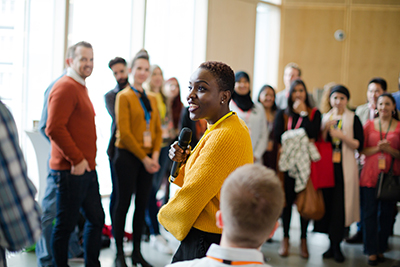
Patient associations
ANRS MIE is part of a Health Democracy approach. The approach recognises the capacity of each individual to know about, decide and act for his or her own health and for the health of the population. This is made possible by pooling knowledge and practices, enabling participative and constructive research.
Last updated on 26 September 2025
Patient associations at the heart of the agency’s work
Patient associations play a crucial role in the research supported by the agency.
By acting as a link between communities and research teams, they provide the experiential knowledge that is essential for developing research projects which meet patients’ real needs. They make it possible to pass on information about medical recommendations to patients and present the various tools at the patient’s disposal to help them make informed decisions. They also help to reach people far from healthcare facilities.
Along with the agency, patient associations have a role to play in raising awareness among public authorities and in setting up appropriate care pathways and prevention tools.
Community research: an approach at the heart of the agency’s scientific strategy
ANRS MIE is committed to ensuring that community-based research is part of a co-directed scientific approach in which community stakeholders are involved at every stage, from project design to the communication of results.
Collaboration is essential to produce inclusive and representative research
Developing community-based research is an intrinsic part of the ANRS MIE strong commitment to working with civil society and associations.
Dialogue and collaboration between researchers, patients and associations is essential if we are to think together, build together and implement projects that tackle the issues and meet the needs of communities and society as a whole.
This co-construction also means that the experiences of patients/users can be taken into account, recognised and legitimised as an essential source of information for the advancement of scientific knowledge. Patients are at the heart of the research process. They play a key role in shaping the medical, social and political decisions that affect them.
Community-based research goes beyond simply evaluating treatments or devices. It also enables us to think about how they can be implemented in real life. This would be impossible without the expertise and on-the-ground knowledge of community players, particularly associations.
A desire to involve voluntary sector representatives in the agency’s decision-making process
Over the years, representatives from the voluntary sector have joined the Agency’s scientific committees and governance bodies to take part in its strategic orientations and decisions. The associations, along with TRT-5 CHV, have been key players in the fight against HIV and viral hepatitis.
By working in close collaboration, representatives of civil society and the academic world enrich one another. They pool their know-how with one goal in mind: to improve prevention, screening and the care provided to patients, including the most vulnerable. They also thrive on improving public health policies for the benefit of society as a whole. This model for fighting against HIV/AIDS has proved its relevance. It can also be beneficial for other diseases, as it promotes transparent, participatory and committed research. Finally, it is also a weapon to combat misinformation and a way of responding to people’s enquiries. For example, in the case of Covid-19, the AprèsJ20 association has joined the agency’s assessment and coordination bodies for long Covid research.
An efficient model that is helping to improve healthcare recommendations
Collaborative working relationships between researchers and associations are a unique and essential model within ANRS | Emerging Infectious Diseases. This model has made a major contribution to innovative community research projects. For example, two trials of pre-exposure prophylaxis (PrEP) in HIV-negative volunteers at high risk of HIV infection, were conducted in collaboration with the AIDES association (association AIDES) and an ad hoc association committee:
- The ANRS IPERGAY trial (2012), the brainchild of TRT-5 and researchers, demonstrated on-demand PrEP effectiveness. On-demand PrEP was subsequently approved by the WHO, and a large number of international recommendations have made PrEP an effective HIV prevention strategy.
- The ANRS PREVENIR study (2017-2020), which follows on the ANRS IPERGAY trial, demonstrated that both daily and on‐demand PrEP regimens were effective and safe after three years of follow-up in real life.
To continue to make this model a sucess, we are working to expand our partnership network, particularly at the international level. This is a priority for ANRS MIE for the next few years.
The establishment of new partnerships with associations, in particular those working on emerging infectious diseases, reflects our determination to continue to align our action with the needs of communities and to value every voice.
